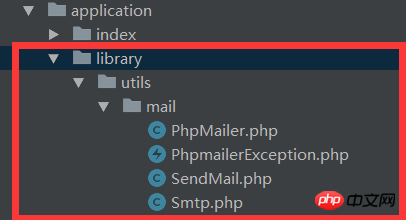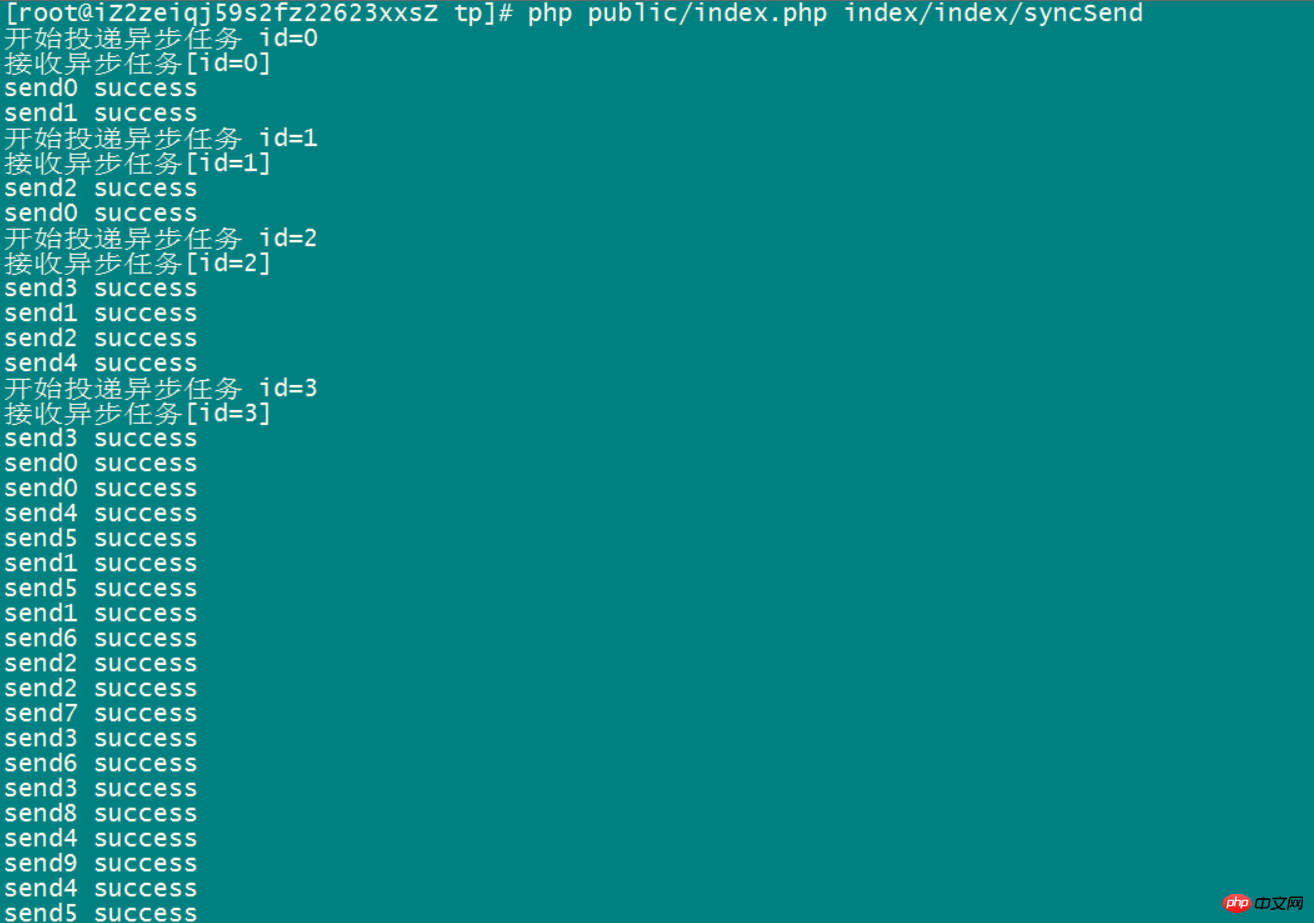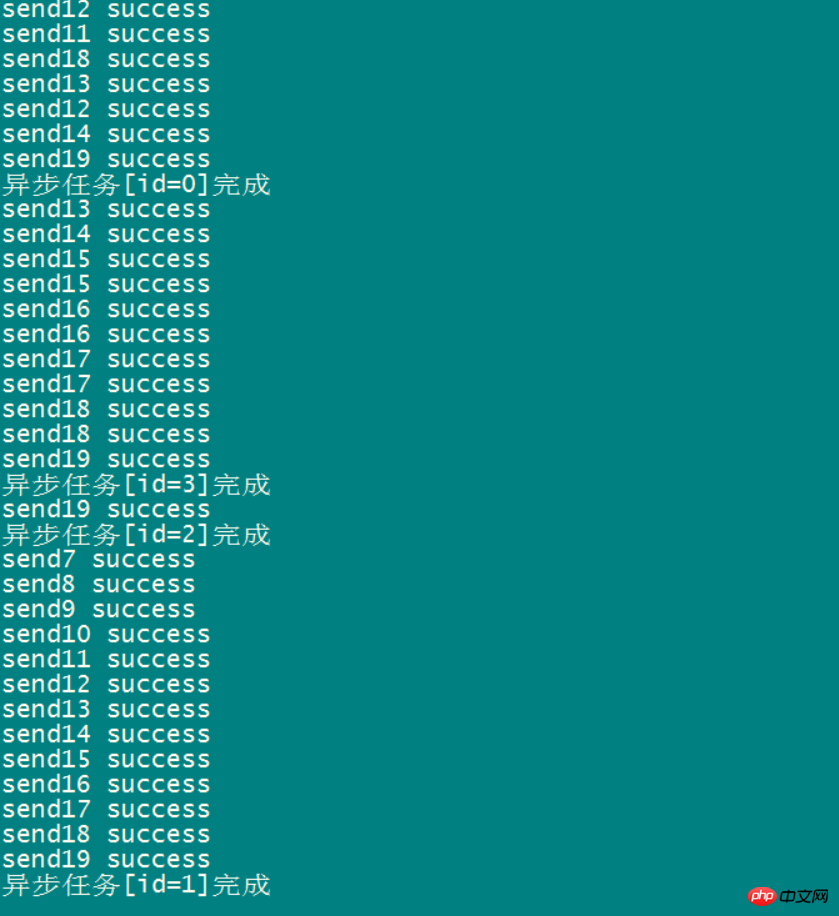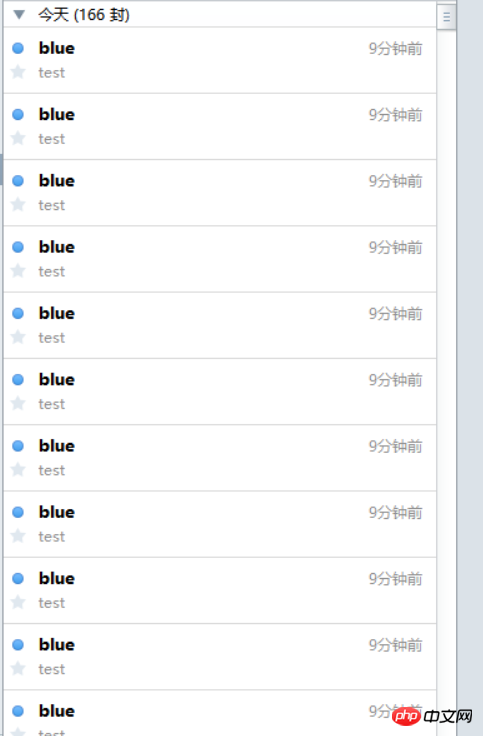 Backend Development
Backend Development
 PHP Tutorial
PHP Tutorial
 Example of using thinkphp5 and swoole to implement asynchronous mass mailing using SMTP
Example of using thinkphp5 and swoole to implement asynchronous mass mailing using SMTP
Example of using thinkphp5 and swoole to implement asynchronous mass mailing using SMTP
This article mainly introduces the detailed explanation of thinkphp5+swoole to implement asynchronous mass mailing (SMTP method). It has certain reference value. Interested friends can refer to it.
This article introduces the implementation of thinkphp5+swoole. Asynchronous mass mailing (SMTP method), share with everyone, the details are as follows:
1. Environment description
Alibaba Cloud centos7
thinkphp5.0.11
swoole2.0.8
##2. tp realizes email sending
Create the following file directory under the project:
namespace app\library\utils\mail;
use app\library\utils\mail\PhpMailer;
use app\library\utils\mail\Smtp;
use think\Log;
error_reporting(E_STRICT);
date_default_timezone_set('Asia/Shanghai');
class SendMail
{
static function postmail($to,$subject = '',$body = ''){
$mail = new PhpMailer();
$mail->CharSet = config('mail.CharSet');
$mail->IsSMTP();
$mail->SMTPDebug = config('mail.SMTPDebug');
$mail->SMTPAuth = config('mail.SMTPAuth');
$mail->SMTPSecure = config('mail.SMTPSecure');
$mail->Host = config('mail.Host');
$mail->Port = config('mail.Port');
$mail->Username = config('mail.Username');
$mail->Password = config('mail.Password');
$mail->SetFrom(config('mail.From'), config('mail.Name'));
$mail->Subject = $subject;
$mail->MsgHTML($body);
$address = $to;
$mail->AddAddress($address, '');
if(!$mail->Send()) {
Log::write('send to '.$to.'error info:'.$mail->ErrorInfo);
return false;
} else {
return true;
}
}
}//邮箱设置 'mail'=>[ 'CharSet'=>'UTF-8', 'SMTPDebug'=>0,// 启用SMTP调试功能 0关闭 'SMTPAuth'=>true,// 启用 SMTP 验证功能 'SMTPSecure'=>'ssl',// 安全协议 'Host'=>'smtp.163.com',// SMTP 服务器 'Port'=>465,// SMTP服务器的端口号 'Username'=>'**********',// SMTP服务器用户名 'Password'=>'**********',// SMTP服务器密码 'From'=>'*********@163.com',// 发件人邮箱 'Name'=>'blue',// 发件人邮箱 ]
2.2 Notes
In this step, we need to pay attention to a few points: 1. Whether the account you set to send the email has opened SMTP and find the corresponding security protocol and port Number. 2. Whether the current server supports SMTP service, which is often affected by some socket functions. When encountering problems, we should set the SMTPDebug parameter to 1, and then debug carefully based on the debug information. 3. Some emails sent will be put into the trash, please check them carefully. 2.3 Call to establish the following file directory structure:
public function sendMail(){
if(SendMail::postmail('937069176@qq.com','test','123')){
echo 'send success';
}else{
echo 'send fail';
}
}2.4 Call result

3. Combined with swoole to achieve asynchronous mass sending 3.1 Installation of swoole
The detailed steps for swoole extension installation are available on the official website, so I won’t go into details. The swoole document portal3.2 Implement asynchronous mass sending
We first implement the asynchronous server: /**
* description:服务端
*/
public function syncSend(){
$serv = new \swoole_server('0.0.0.0',8082);
$serv->set(array('task_worker_num' => 4));
$serv->on('receive', function($serv, $fd, $from_id, $data) {
$task_id = $serv->task($data);
echo "开始投递异步任务 id=$task_id\n";
});
$serv->on('task', function ($serv, $task_id, $from_id, $data) {
echo "接收异步任务[id=$task_id]".PHP_EOL;
for ($i = 0 ; $i<20;$i++){
if(SendMail::postmail('937069176@qq.com','test',$data)){
echo 'send'.$i.' success'."\n";
}else{
echo 'send'.$i.' fail'."\n";
}
}
$serv->finish('');
});
$serv->on('finish', function ($serv, $task_id, $data) {
echo "异步任务[id=$task_id]完成".PHP_EOL;
});
$serv->start();
} /**
* description:客户端
*/
public function index()
{
$client = new \swoole_client(SWOOLE_SOCK_TCP, SWOOLE_SOCK_SYNC);
$ret = $client->connect("127.0.0.1", 8082);
if(empty($ret)){
echo 'error!connect to swoole_server failed';
} else {
$client->send('blue');//这里只是简单的实现了发送的内容
}
}netstat -apn | grep 8082
kill -9 PID(进程号)
php public/index.php index/index/syncSend
php public/index.php index/index/index




4. Postscript~
swoole is an extension that you want to be familiar with and use proficiently, but it is limited to network programming knowledge. Insufficient, so you still need to test and learn more. If there are any deficiencies in the demo, please point out the QAQThe above is the detailed content of Example of using thinkphp5 and swoole to implement asynchronous mass mailing using SMTP. For more information, please follow other related articles on the PHP Chinese website!

Hot AI Tools

Undresser.AI Undress
AI-powered app for creating realistic nude photos

AI Clothes Remover
Online AI tool for removing clothes from photos.

Undress AI Tool
Undress images for free

Clothoff.io
AI clothes remover

Video Face Swap
Swap faces in any video effortlessly with our completely free AI face swap tool!

Hot Article

Hot Tools

Notepad++7.3.1
Easy-to-use and free code editor

SublimeText3 Chinese version
Chinese version, very easy to use

Zend Studio 13.0.1
Powerful PHP integrated development environment

Dreamweaver CS6
Visual web development tools

SublimeText3 Mac version
God-level code editing software (SublimeText3)

Hot Topics
 How to use swoole coroutine in laravel
Apr 09, 2024 pm 06:48 PM
How to use swoole coroutine in laravel
Apr 09, 2024 pm 06:48 PM
Using Swoole coroutines in Laravel can process a large number of requests concurrently. The advantages include: Concurrent processing: allows multiple requests to be processed at the same time. High performance: Based on the Linux epoll event mechanism, it processes requests efficiently. Low resource consumption: requires fewer server resources. Easy to integrate: Seamless integration with Laravel framework, simple to use.
 How to use Swoole to implement a high-performance HTTP reverse proxy server
Nov 07, 2023 am 08:18 AM
How to use Swoole to implement a high-performance HTTP reverse proxy server
Nov 07, 2023 am 08:18 AM
How to use Swoole to implement a high-performance HTTP reverse proxy server Swoole is a high-performance, asynchronous, and concurrent network communication framework based on the PHP language. It provides a series of network functions and can be used to implement HTTP servers, WebSocket servers, etc. In this article, we will introduce how to use Swoole to implement a high-performance HTTP reverse proxy server and provide specific code examples. Environment configuration First, we need to install the Swoole extension on the server
 How does swoole_process allow users to switch?
Apr 09, 2024 pm 06:21 PM
How does swoole_process allow users to switch?
Apr 09, 2024 pm 06:21 PM
Swoole Process allows users to switch. The specific steps are: create a process; set the process user; start the process.
 Which one is better, swoole or workerman?
Apr 09, 2024 pm 07:00 PM
Which one is better, swoole or workerman?
Apr 09, 2024 pm 07:00 PM
Swoole and Workerman are both high-performance PHP server frameworks. Known for its asynchronous processing, excellent performance, and scalability, Swoole is suitable for projects that need to handle a large number of concurrent requests and high throughput. Workerman offers the flexibility of both asynchronous and synchronous modes, with an intuitive API that is better suited for ease of use and projects that handle lower concurrency volumes.
 How to restart the service in swoole framework
Apr 09, 2024 pm 06:15 PM
How to restart the service in swoole framework
Apr 09, 2024 pm 06:15 PM
To restart the Swoole service, follow these steps: Check the service status and get the PID. Use "kill -15 PID" to stop the service. Restart the service using the same command that was used to start the service.
 Which one has better performance, swoole or java?
Apr 09, 2024 pm 07:03 PM
Which one has better performance, swoole or java?
Apr 09, 2024 pm 07:03 PM
Performance comparison: Throughput: Swoole has higher throughput thanks to its coroutine mechanism. Latency: Swoole's coroutine context switching has lower overhead and smaller latency. Memory consumption: Swoole's coroutines occupy less memory. Ease of use: Swoole provides an easier-to-use concurrent programming API.
 Swoole in action: How to use coroutines for concurrent task processing
Nov 07, 2023 pm 02:55 PM
Swoole in action: How to use coroutines for concurrent task processing
Nov 07, 2023 pm 02:55 PM
Swoole in action: How to use coroutines for concurrent task processing Introduction In daily development, we often encounter situations where we need to handle multiple tasks at the same time. The traditional processing method is to use multi-threads or multi-processes to achieve concurrent processing, but this method has certain problems in performance and resource consumption. As a scripting language, PHP usually cannot directly use multi-threading or multi-process methods to handle tasks. However, with the help of the Swoole coroutine library, we can use coroutines to achieve high-performance concurrent task processing. This article will introduce
 How is the swoole coroutine scheduled?
Apr 09, 2024 pm 07:06 PM
How is the swoole coroutine scheduled?
Apr 09, 2024 pm 07:06 PM
Swoole coroutine is a lightweight concurrency library that allows developers to write concurrent programs. The Swoole coroutine scheduling mechanism is based on the coroutine mode and event loop, using the coroutine stack to manage coroutine execution, and suspend them after the coroutine gives up control. The event loop handles IO and timer events. When the coroutine gives up control, it is suspended and returns to the event loop. When an event occurs, Swoole switches from the event loop to the pending coroutine, completing the switch by saving and loading the coroutine state. Coroutine scheduling uses a priority mechanism and supports suspend, sleep, and resume operations to flexibly control coroutine execution.





